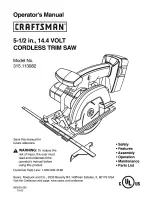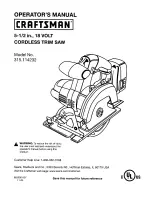
20
| English
– Switch the power tool off and pull the mains plug out of
the socket.
– Wait until the saw blade has come to a complete stop.
– Determine the cause of the blockage and eliminate it.
u
Avoid dust accumulation at the workplace.
Dust can
easily ignite.
u
To prevent the risk of fire when sawing aluminium,
empty the chip ejector and do not use chip extraction.
Emptying the chip ejector (see figure i)
You can open the lower saw blade cover
(52)
to remove
workpiece fragments and large chips.
– Switch the power tool off and pull the mains plug out of
the plug socket.
– Wait until the saw blade has come to a complete stop.
– Tilt the power tool sideways.
– Loosen the fastening screws
(53)
and open the lower saw
blade cover
(52)
.
– Remove workpiece fragments and chips.
– Close the lower saw blade cover and screw it back on.
– Bring the power tool into the work position.
External dust extraction (see figure j)
– Firmly insert a suitable dust extraction hose into the dust
extraction adapter
(34)
.
The dust extractor must be suitable for the material being
worked.
When extracting dry dust that is especially detrimental to
health or carcinogenic, use a special dust extractor.
Changing the saw blade (see figures k1−k4)
u
Pull the plug out of the socket before carrying out any
work on the power tool.
u
When mounting the saw blade, wear protective
gloves.
This poses a risk of injury.
u
Only use saw blades the maximum permitted speed of
which is higher than the no-load speed of the power
tool.
u
Only use saw blades that match the specifications
given in this operating manual and that are tested and
marked in accordance with EN 847-1
u
Only use saw blades that are recommended by the
power tool manufacturer and are suitable for use on
the material you want to saw.
This prevents the saw
tooth tips from overheating and the plastic you want to
saw from melting.
u
Do not use HSS saw blades.
Such saw blades can easily
break.
Removing the saw blade
– Turn the crank
(17)
clockwise as far as possible so that
the saw blade
(28)
is in the highest possible position
above the saw table.
– Fold the protective cover
(6)
backwards.
– Lift the table insert
(8)
by the gripping hole
(54)
and re-
move it from the tool chamber.
– Unscrew the hexagon screw
(56)
anticlockwise with the
ring spanner
(35)
while holding the clamping flange
(55)
in place with the hook spanner
(36)
.
– Remove the washer
(57)
and the clamping flange
(55)
.
– Remove the saw blade
(28)
.
Fitting the saw blade
If required, clean all the parts you want to fit before installing
them.
– Place the new saw blade on the mounting flange
(58)
of
the tool spindle.
Note:
Use sufficiently large saw blades. The radial clearance
between the saw blade and the riving knife must not exceed
3−8 mm (max.).
u
When fitting the saw blade, make sure that the cutting
direction of the teeth (arrow direction on the saw
blade) matches the direction of the arrow on the pro-
tective cover.
– Fit the clamping flange
(55)
, the washer
(57)
and the
hexagon screw
(56)
.
– Tighten the hexagon screw
(56)
clockwise with the ring
spanner
(35)
while holding the clamping flange in place
with the hook spanner
(36)
.
– Reinsert the table insert
(8)
.
– Fold the protective cover
(6)
forwards.
Operation
u
Pull the plug out of the socket before carrying out any
work on the power tool.
Transport position and work position of the saw
blade
Transport position
– Remove the protective cover
(6)
, remove the table insert
(8)
and place the riving knife
(27)
in the bottom position.
Reinsert the table insert
(8)
.
– Turn the crank
(17)
anticlockwise until the teeth of the
saw blade
(28)
lie below the saw table
(4)
.
– Push the saw table expansion
(10)
in fully.
Push the clamping handle
(20)
down. This fixes the saw
table expansion in place.
Work position
– Position the riving knife
(27)
in the top position directly
over the centre of the saw blade, insert the table insert
(8)
and fit the protective cover
(6)
.
– Turn the crank
(17)
clockwise until the top teeth of the
saw blade
(28)
are approx. 3−6 mm above the work-
piece.
Setting mitre and bevel angles
To ensure precise cuts, the basic settings of the power tool
must be checked and adjusted as necessary after intensive
use.
1 609 92A 72G | (29.10.2021)
Bosch Power Tools
Содержание 3 601 M45 080
Страница 3: ... 3 1 2 4 3 6 5 19 17 14 7 18 11 9 10 8 12 13 16 15 Bosch Power Tools 1 609 92A 72G 29 10 2021 ...
Страница 4: ...4 25 18 29 23 20 22 21 36 33 34 31 30 28 27 35 32 31 26 19 1 609 92A 72G 29 10 2021 Bosch Power Tools ...
Страница 5: ... 5 a1 a2 37 38 13 14 Bosch Power Tools 1 609 92A 72G 29 10 2021 ...
Страница 6: ...6 a3 b 14 31 39 13 31 31 1 609 92A 72G 29 10 2021 Bosch Power Tools ...
Страница 8: ...8 h1 i j k1 h2 3 51 5 34 6 7 49 k2 50 8 54 52 53 53 1 609 92A 72G 29 10 2021 Bosch Power Tools ...
Страница 10: ...10 D E F1 19 2 63 62 9 43 10 9 47 25 19 F2 1 609 92A 72G 29 10 2021 Bosch Power Tools ...
Страница 12: ...12 K L M N 63 69 70 1 33 62 43 71 29 12 21 1 609 92A 72G 29 10 2021 Bosch Power Tools ...
















































